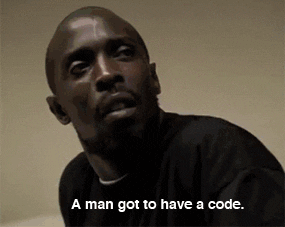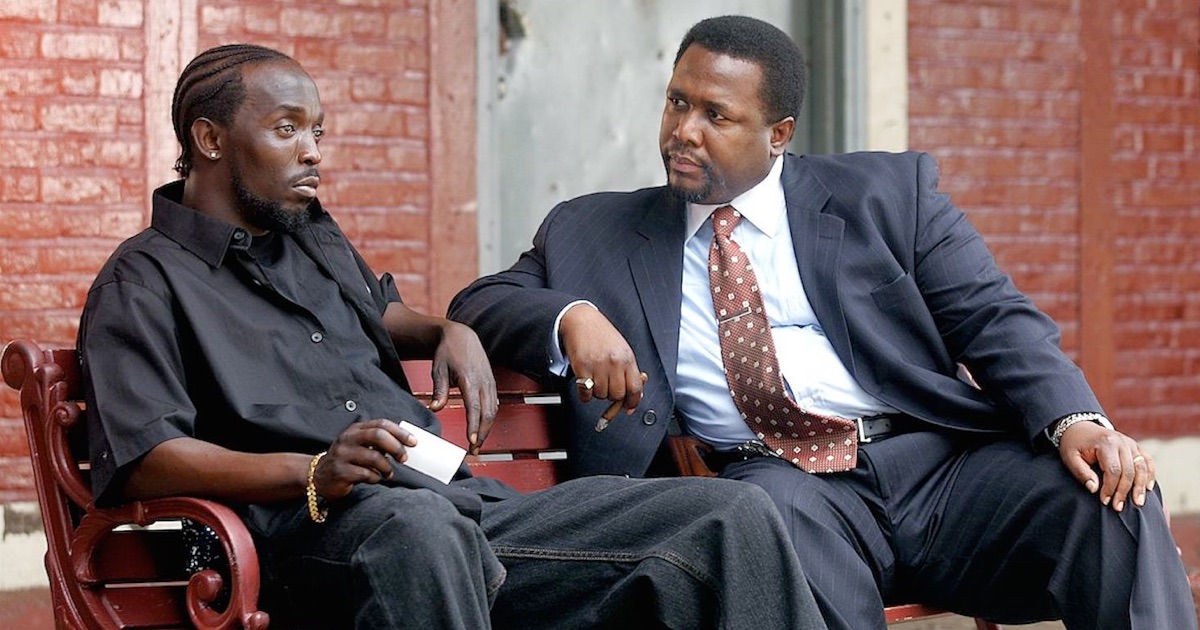What makes a great scene?
Sometimes, it asks a question that hooks you. (TV pilot writers depend on this.)
Other times, a scene stands out because of what isn’t said.
HBO’s The Wire has more great scenes than almost any other TV series in history. And when actor Michael K. Williams died this week, his fans flooded Twitter with gifs and clips from the most iconic role of Williams’s career, as The Wire‘s terrifyingly charismatic outlaw Omar Little.

Over at The Ringer, writer Rob Harvilla penned a touching summary of Williams’s work. But although Williams was involved in some of the most memorable moments in The Wire, Harvilla chose to highlight the following scene, which I had forgotten about completely.
Why this scene? For Harvilla, it stands out because of what William’s doesn’t do:
It is enough for Williams to be nearly silent, to be effortlessly menacing, but with an ocean of mesmerizing intensity roiling underneath.
I hadn’t watched this scene since I first saw The Wire on DVD back in 2009, so I rewatched it now to see why it had stayed in Harvilla’s mind for so long.
It turns out he’s right. This is a great scene.
Let’s look at all the reasons why.
What Does Every Great Scene Need?
Every scene in a film or TV series operates on three different storytelling levels:
- The text (what the characters do or say)
- The subtext (what the characters want or need)
- The theme (what the scene is about, and how it fits within the overall theme of the entire film or series)
Most importantly, by the end of each scene, something about the story — and our perception of the plot, the characters, or the theme — has changed. And when these elements all work in tandem, as they do here, it can truly elevate a scene above the norm.
The scene we’re discussing, from The Wire Season 3 Episode 6 “Homecoming,” succeeds on all three storytelling levels. Written by David Simon and Rafael Alvarez and directed by Leslie Libman, the text is why it happens, but the subtext and theme are why it resonates.
Who’s the Cat and Who’s the Mouse?

The text of this scene is a classic cops vs. criminals conflict, but the questions it asks have more to do with the soul of the city of Baltimore than the case at hand.
Detective Bunk Moreland (Wendell Pierce) is investigating a murder that Omar might know something about. Bunk leans on Omar, expecting him to offer up some information, but instead Omar pulls the rug out from under him: not only will Omar not cooperate, but Bunk’s witness is already changing his story (presumably due to Omar’s influence).
This is the scene’s first pivot: Bunk thought he had an easy win, but he finds out Omar actually has the upper hand.
Now, if Bunk gave up easily, we wouldn’t have a scene. So he tries several other tactics to get what he needs. He tries appealing to Omar’s sense of justice. He tries intimidating him. He even tries demeaning him. But none of it works.
Fed up and realizing that Omar’s going to win this particular round, Bunk changes gears one last time: he accuses Omar of lacking humanity — of becoming a cancer that’s eating away at the city they both grew up loving.
As Bunk walks away, he hopes he at least made a point even if he didn’t get the win. But Omar spits on the ground Bunk was walking on, demonstrating just how little he cares for Bunk’s opinion. Bunk leaves, disgusted.
… and yet, in the final shot, we see that Bunk’s words may be eating away at Omar in a way that he can’t possibly admit.
Revealing Character through Choices
Every conflict between characters is a series of choices they make in reaction to one another.
In this scene, Bunk starts out feeling smug, maybe even cocky. He thinks he has Omar right where he wants him. But Omar has already outsmarted him even before their conversation begins. As this dawns on Bunk, we see his expressions and behaviors change from surprise to desperation to disgust.
We also get to see under the hood of how Bunk thinks.
Like most cops in The Wire, Bunk believes himself to be better than the criminals he deals with. But deep down, he knows just how close he could have come to becoming a criminal himself.
When Bunk tries to physically intimidate Omar, Omar doesn’t even blink. This underscores Bunk’s childhood recollection of the time the tough guys told him to “go home, schoolboy.” Sure, they may have been trying to warn him away from taking the crooked path in life. But what Bunk is still wrestling with internally is the fact that he never would have survived on the streets anyway. He may talk a big talk, but when it all comes down to it, he’s too soft.
The twist?
Choosing to display the very compassion that could have been seen as a weakness and gotten him killed on the streets just might be what helps Bunk get through to Omar when every other tactic fails.
Conveying the Theme of a Scene with Motion
If this was just a scene of Bunk and Omar arguing next to each other on a bench, it would still be compelling based on their performances alone. But The Wire is full of scenes with two people arguing over something, so the show’s actors and directors always need to find new ways to make each confrontation feel fresh.
In this case, Omar remains seated the entire time, while Bunk is the one who keeps moving — which mirrors his continually shifting tactics. He’s usually towering over Omar, which implies that he has the moral high ground, but he doesn’t have control of the situation. By comparison, Omar exerts his power by doing nothing at all.
As for the seat itself, it almost feels like a throne of trash — part pinnacle, part trap. The way it’s filmed also matches the scene’s subtext. In the first shot, we move across a burned-out cityscape in a wide angle to find Omar awaiting Bunk’s doomed visitation. But by the final shot, the camera retreats from Omar’s face back into that same derelict building, which — like Omar’s certainty — is now out of focus.
All of which supports The Wire‘s central theme: just when you think you have everything figured out, you realize you know nothing at all.


0 Comments